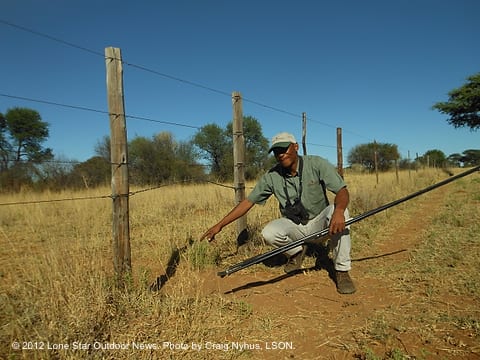 In pronghorn and desert bighorn country, West Texas ranches could learn a thing or two by looking at the fences from African “farms.”
In pronghorn and desert bighorn country, West Texas ranches could learn a thing or two by looking at the fences from African “farms.”
The fences allow wild, and very large, animals that aren’t jumpers to easily access the other side by going under the fence without injury.
And some organizations are working to get more animal movement-friendly fencing installed in the U.S.
The fencing at the property of Deithelm and Katja Metzger at Makadi Safaris in Namibia uses high tensile galvanized steel wires with no barbs, Deithelm Metzger said.
The wooden posts are about 18 meters apart, with usually 5 “spacers”, smaller wooden posts cut just beneath the bottom wire.
“The bottom wire is a little higher and a little more loose so the animals don’t have any problem going under the fence,” he said. “And along the game trails, we use holes by taking off the lowest two wires.”
The holes occur about every 400 meters, and are used by larger animals like ostrich, gemsbok and even zebra and giraffe, Metzger said.
Gemsbok and red hartebeest are regularly observed going under the fence with ease, even with their large bodies and long horns.
“And most of the crossings are right in the middle between the two posts,” said professional hunter John Jacobs. “The animals figure out where it is easiest to cross.”
But what about the cattle, since the African “farm” is synonymous with the Texas ranch, and most mix their cattle and hunting operations.
“We haven’t had any trouble with the cattle at all,” said Katja Metzger. “The calves do go under the fence, but they just cross right back to be with their mother.”
Diethelm Metzger, who attended graduate school at Texas A&M University, is at a loss why the barbed wire remains so common in Texas.
“It rusts, it sags because you can’t pull it as tight and it doesn’t last as long,” he said.
Organizations that support the pronghorn and wild sheep are trying to change the reliance on the standard, barbed wire fencing in areas where these animals live to allow for movement throughout their corridors.
In Wyoming, the Wyoming Land Trust, through its Corridor Conservation Campaign, is working through its partners, consisting of industry, governmental and conservation groups, to install 500 miles of wildlife- and livestock-friendly fencing.
The campaign pays to modify the fences at no cost to the landowners if existing fences impede migration in key wildlife migration routes.
So far, the campaign has replaced hundreds of miles with fencing with a bare lowest wire set at 18 inches from the ground and a increased spread in the top two strands.
Dr. Louis Harveson, Director of the Borderlands Research Institute at Sul Ross State University in Alpine said wildlife-friendly fencing has been installed in increasing numbers in Texas’ pronghorn country, especially in the Trans-Pecos region.
“NRCS (National Resources Conservation Service, a division of USDA) has a good program for improving pronghorn habitat, and it includes funding assistance for landowners to switch out their fences,” he said. “After the wildfires last year, several landowners used it to put in fences more favorable to pronghorns.”
At the institute, other fencing options also are being studied.
“We’re trying to associate visual cues for the animals,” Harveson said. “We use PVC pipe as a cue to where the pronghorn can cross under the fence. We’re putting these in the areas where the relocation of pronghorn from the Panhandle to the Trans-Pecos will take place in January.”
In the desert bighorn country in Texas, the Texas Bighorn Society has established its Big Bend Conservation Corridor Initiative, which director Robert Joseph of Lubbock said will include issues relating to fencing.
“At one of our work projects, a landowner asked if we could help modify the current fence and we created 21-inch spaces at the bottom to allow the sheep to move through,” he said.
Kai Buckert, ranch manager at the Lado Ranch in Big Bend, said their fencing modifications were less complex.
“We are removing a lot of the old sheep fencing that was installed in the 40s,” he said. “The old sheep panels held the wild sheep in and they couldn’t escape from predators. We cut the wire in 50- to 100-foot sections and rolled it up — we didn’t want to pack it down the mountain.
The rolled up wires had an added benefit.
“We left it in piles to create habitat for the smaller animals,” he said. “You wouldn’t believe the number of nests of quail and other small animals in the piles.”


1 comment
Great article.
Comments are closed.